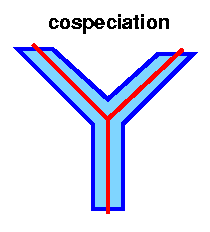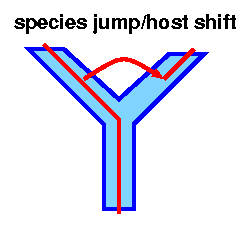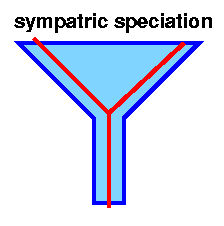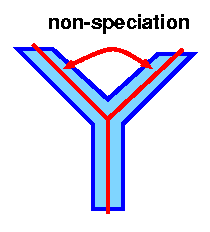Host specificity
The basic question for this week is:
what determines parasite specificity?
We can define specificity at a number of levels,
from the breadth of a parasite's choice of spatial
position within a host organ such as the gut, to
differences in parasite performance in different
host subpopulations (this connects to last week's
RQ discussions), to the range of species that parasites
are able to exploit.
The evolutionary reasoning and consequences behind
parasite specificity are
interesting and important. Parasite specificity for hosts has
connections to the entirely general question in evolution of why there
are species at all: why don't we just have one big life form that is
good at everything? What is the balance between plasticity
(the capability to express different phenotypes in different environments)
and specialization?
Some preliminaries:
Encounter and compatibility filters
Combes is big on the idea that parasite success,
and parasite specificity, are determined by these
two processes or "filters". I don't think it
explains everything, but it is a useful
distinction.
- Encounter filter: this filter determines whether
the parasite can ever find the host. It is affected by the
large-scale spatial distribution of the host and parasite (geography);
the small-scale spatial distribution (habitat use); the behavior of
H and P (e.g. circadian rhythms/chronobiology); the ecology of
the host (e.g. for trophically transmitted parasites, whether
the host ever eats the upstream host). Both parasites and
hosts can "try" to open or close the encounter filter by
modifying their behavior to chase or avoid each other.
- Compatibility filter: determines whether
the parasite succeeds in infecting the host and reproducing
once it makes contact with the host.
Biochemistry, immune system, etc..
Sampling issues
How do we really know what the host range of a parasite is?
Often we try to draw conclusions about specificity from large
databases assembled from the literature about the number
of hosts that have been recorded for different kinds of parasites.
- Sampling: if some kinds of species are systematically undersampled
(e.g. species that live in inaccessible habitats, species that don't
parasitize humans), then we could draw misleading conclusions.
- Cryptic species: since parasites are often
morphologically simple (often all we have to go on are
mouthparts and genitalia, since everything else is unnecessary),
parasites specific to two or more different hosts are
often lumped into a single species. Equally, generalist parasites
on different hosts could be misidentified as separate
species (e.g. on the basis of plastic traits or
morphological adaptations) even when there is gene
flow between the subpopulations.
Obviously, mistakes like this will bias our conclusions
about specificity. Combes gives some
examples.
Why specialization?
We can broadly divide explanations into two categories,
adaptive and isolation/drift.
Adaptive explanations are more closely connected with microevolutionary
processes (the change of gene frequencies within populations), while
isolation/drift arguments are more closely connected with
macroevolutionary patterns (the patterns of species
and higher-level taxa). Speciation is the link
between micro- and macroevolution. Everything in evolution
is either too big and slow, or too small and fast; studies
of microevolutionary processes must be extrapolated to see
if they match macroevolutionary patterns, while studies of
macroev. patterns must be consistent with microev. processes.
Basic adaptive explanations for specialization:
- There may be basic physiological tradeoffs that
constrain the viability and fecundity
of parasites on different
hosts; you can do better by specializing on
one than by generalizing on many (analogous to
the frequency-independent lottery model
for maintenance of sexual reproduction).
Specialization may be increased by feedback, as
parasites choose to restrict themselves to a specific
host.
- Tradeoffs may be frequency-dependent
("tangled bank") instead; specialists may be
able to compete better with other parasites within
a host
- The advantage to specialization, and disadvantage
to generality, may be in your ability to adapt
to your host: the Red Queen returns
Isolation/drift arguments say that specificity is
not driven by tradeoffs between hosts, but by the
random loss (via mutation or drift) of the ability
to utilize a host that is never seen by
the parasite population.
Levels of specialization
Specialization can occur at the level of:
- organs, or parts of organs, within a host;
- individual hosts, in cases where there are
multiple generations of parasites on a single host
(Karban, "Fine-scale adaptation of herbivorous thrips to
individual host plants": Nature, 340,
60-61),
or (possibly) HIV within hosts
- families or local populations:
in measles epidemics in West Africa, there is some evidence that
the first ("index") case in a family is milder than subsequent
infections in the same family. This may be evidence that the
virus is adapting to the shared portions of the family's genotype
(although there are other explanations, such as the possibility that
healthier children with better immune systems are more active outside
the household and thus more likely to acquire infection).
- species
We will mostly be discussing the latter two cases (local populations
and species), although we will come back to #1 later when
we discuss within-host competition.
Processes
Rather than looking at patterns at the broad scale
of host and parasite phylogenies, and making inferences
about what kinds of jumps and extinctions have happened
in the past, we can look directly at the ecological or
microevolutionary processes that lead to the different
patterns (cospeciation, host jumps, extinction, etc.)
Examples:
- Diplozoon gracile (monogenean) may be in the process of jumping
back to Barbus barbus, in places where there is hybridization
between B. barbus and B. meridionalis.
The compatibility filter is open, as proved by experimental infection
of B. barbus in the lab; the difference in infection rates
is (presumably) not caused by genetic differences. Combes' explanation
for the observed pattern that parasitism is correlated
with meridionalis genes is that the encounter filter is
related to behavior (habitat choice), which in turn is determined
by genetics. (Comparisons of parasite load in hybrids can be
tricky, since hybrids often have screwed-up immune systems, but
this conclusion seems reasonable.)
- Lepeophtheirus europaensis (copepod) on
flounder and brill; the compatibility filter
is open (cross-infection occurs in the lab)
and the encounter filter is apparently open,
since the two species live in similar habitats, but
parasites are not found crossing over. This appears
to be through "choice", since parasites have lower
reproductive output on the "wrong" hosts. Is this
speciation in action?
- Howardula aeronymphus (nematode on Drosophila):
by maintaining the parasite on one species in the lab, it loses the
ability to infect other species
(J. Jaenike, "Rapid evolution of host specificity in a parasitic
nematode", Evolutionary Ecology 7, 103-108).
This has important implications: it gives some concrete evidence
for genetic divergence of isolated parasite populations.
This raises the question of what is happening here:
how, exactly, is the parasite losing its ability to
infect the other species?
Is this caused by the relaxation of tradeoffs, or just by random
mutation in (say) the part of the genome that controls ability to
infect the other species? Many generalist or opportunist pathogens
have big genomes (Pseudomonas aeruginosa), presumably
precisely for this reason. Is there actually a disadvantage to having
a big genome? How would you tell?
Correlations
One way to step between micro- and macro-patterns is to
look at broad-scale correlations between ecological and
evolutionary characteristics of parasites/hosts and their
specificity.
Ecological explanations
Some of the explanations are essentially ecological,
based on observations and arguments about the
compatibility and encounter filters:
- orally transmitted or vector-borne
parasites (esp. passively transmitted ones) are less specific
than parasites with direct transfer [encounter filter]
- parasites with complex life cycles are less specific? (need to
allow flexibility/open encounter filter?)
- parasites in smaller geographic areas are less specific
(same as above, need to allow flexibility)
- Host abundance: stable, abundant populations of hosts
should promote specificity ("resource fragmentation"
hypothesis, Janzen 1981
(available from
JSTOR)
Evolutionary explanations
- parasites from species-rich taxa will be less host-specific,
since they have the opportunity to jump onto many "similar" hosts
- older host-parasite associations more specific, since
they have had more time to evolve specificity
Macroevolutionary explanations/explorations
Cospeciation and Fahrenholz' rule
Macroevolution refers to the processes driving
extinction and speciation of different "higher-order taxa",
typically at the species level or above.
Cospeciation is such a process:
it corresponds to vicariant speciation in general
evolution, as when continental drift separates two continents.
If parasites stay with their hosts and
speciate with them then the phylogeny of the hosts and
of the parasites will match (Fahrenholz' rule).
The possibilities are:
- cospeciation: parasites remain in both host
daughter species, and gene flow among parasites
stops so that parasites speciate too
(e.g. lice in pocket gophers)

- "missing the boat": the parasite fails to transfer
to one branch, or goes extinct at some point

- species jump/host shift: some time later (possibly
much later), the parasite transfers laterally to another
taxon. Jumps to distantly related species may occur,
in which case host and parasite phylogenies will no
longer be congruent

- Speciation of parasites within a host population,
or "sympatric" speciation may occur, if parasites
specialize/gene flow is interrupted in parasites
that live on a single host species (e.g., specialization
to different body parts in mites)

- Parasite speciation may not occur at all, if
parasite gene flow is maintained despite host
separation

We can look at the patterns in host and parasite lineages at many
different scales, from the large-scale patterns of parasite
and host lineages to small-scale patterns of local adaptation
(e.g., Curt Lively's snails and trematodes again). There is almost
certainly enough gene flow among hosts and parasites in New Zealand
lakes to keep the subpopulations from speciating, but there is little
enough that we can still see evidence of "specialization" (better
success of parasites on local hosts) in these populations.
It's worth being open-minded about gene flow; although species are
fundamentally different from subpopulations because they have diverged
evolutionarily, it can be very tough to draw hard and fast lines. For
example, in Peter and Rosemary Grant's studies of Darwin's finches on
the Galapagos, they have found that interspecific hybrids are fertile
and that genes can thus move from one species to another. There are
also many cases where populations below the level of species
experience some degree of limited gene flow. The relative balance of
gene flow and of parasite flow among populations will determine the
overall degree of host specialization, parasite specialization, and
host-parasite specificity.









